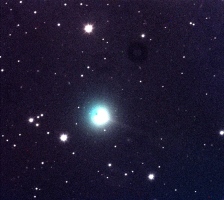Long-time RASC member David Levy has discovered another comet visually near Saturn in the pre-dawn sky as reported by the Central Bureau of Astronomical Telegrams (circular 8757). David Levy is a life member of the Society attached to the Kingston Centre and also serves as their Honorary President. Congratulations!
When RASC member David H. Levy began introducing himself as "someone who used to discover comets," you knew the sport of amateur comet hunting was being squeezed by competition from the fast survey programs such as LINEAR that scoop up comets far and wide. Nevertheless, David's persistence was rewarded again, on October 2, when — 1136 hours of comet hunting after his last visual discovery in 1994 — Comet C/2006 T1 scudded into range of David's 40cm telescope. Confirmed by dozens of observations over the subsequent 24 hours — most notably the official confirmation from an observer in England — David now has his ninth visual discovery. It's nice to see David back on the scoreboard in what he calls "the slowest sport."
In his foreword to the RASC Comets Section, David wrote that "it's harder than it used to be, and many searchers will give up." Often asked about his commitment to visual observing in the face of government-funded projects that use larger aperture optical systems and automated searching routines, David always refers to the sheer joy of the hunt.
But although the hunt is satisfying, David doesn't deny that the thrill of discovery is intense and sweet. Again using sport as his metaphor, David says "I know how a baseball player must feel when they stand at the plate, hear the bat smack the pitch perfectly and feel the ball take off for the outfield bleachers." David compares that instant when the home run specialist knows it's outta here to the feeling he had about 04:10, Tucson time, when his was the first human eye to spot C/2006 T1 (Levy).
 |
| Comet C/2006 T1 (Levy) on the morning of 2006-10-03. Photo by Tom Glinos. |
His routine search procedure above the pre-dawn horizon carried him past Saturn -- always a welcome sight, like a mini-discovery all on its own. About six-tenths of a degree further was a small fuzzy glow. David's first reaction was that it must be a reflection of Saturn's disk inside his telescope, and he carried on. But reflections are reflections and they have a characteristic look to them. As David often says in his lectures, two important skills a comet hunter should develop are "knowing what a comet looks like, and knowing what a comet doesn't look like." Comets don't really look like reflections, and that simple realization brought David back to the 10th magnitude object beside Saturn. Switching to a 20cm f/11 telescope mounted piggyback on his big reflector, David saw the same fuzzball. A reflection, of course, wouldn't show up the same way in both telescopes.
Excitement mounting, and knowing dawn would soon be upon him, David fired up his 36cm Meade Autostar camera and snapped off seven digital shots. When he looked at the first one on his computer screen, one of the world's most experienced comet observers knew it was a home run. Immediately David fired off an email to Dan Green of the Minor Planet Center at Harvard University. David's pictures showed the new comet moving, even over just a few minutes, and yielded position measurements that David submitted.
Thanks to the wide notification we all take for granted these days, more measurements flooded in to the Minor Planet Center. The comet was about 1.7 AU from the sun when David found it. A preliminary orbit was quickly calculated, showing that C/2006 T1 (Levy) will reach perihelion within a week of discovery. RASC 1VP Dave Lane was able to generate a finder chart that presents the path of the comet across southern Leo, and RASC Treasurer Dave Clark has whipped up a 5MB animated graphic that shows the orbit of the comet and the inner solar system.
David figures that an outburst just before discovery made the comet suddenly brighten. It's hard to imagine the high-powered surveys having missed C/2006 T1 otherwise. The comet won't get much brighter and will be a challenging object for observers as it glides across the sky to the south — and away from the Earth — over the coming months, leaving behind a rejuvenated twinkle in its discoverer's eyes.
| Attachment | Size |
|---|---|
| 22.51 KB | |
| 26.84 KB |
